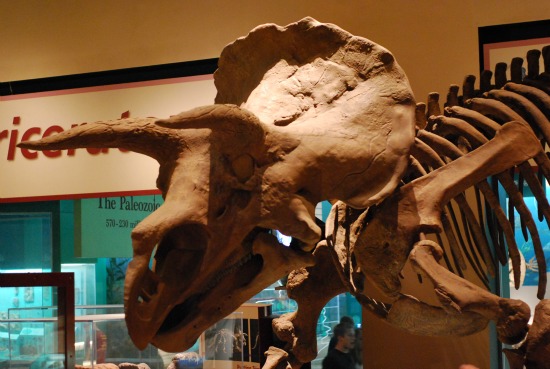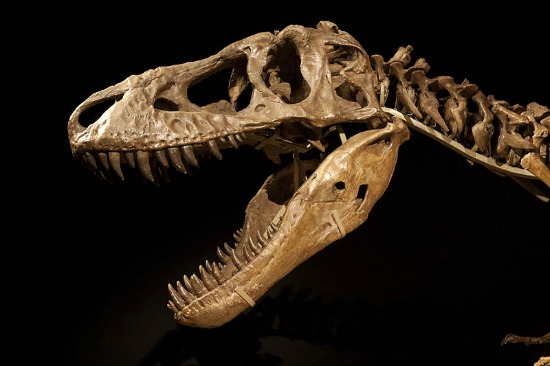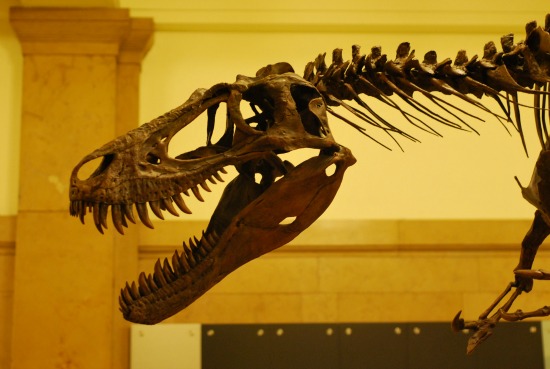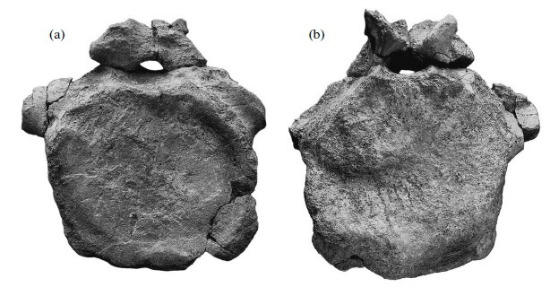Updated: 2012-09-28 22:30:29
<pSANTA CRUZ, CA--White sharks, the largest predatory sharks in the ocean, are thought of as apex predators that feed primarily on seals and sea lions. But a new study by researchers at the University of California, Santa Cruz, shows surprising variability in the dietary preferences of individual sharks. read more
Updated: 2012-09-28 22:00:12
The University of Notre Dame has received a five-year, $6.1 million award from the National Science Foundation to support the continuation of the nationwide QuarkNet program, which uses particle physics experiments to inspire students and provide valuable research, training and mentorship opportunities for high school teachers.read more
Updated: 2012-09-28 15:17:50

Triceratops was an awesome dinosaur, but, despite one site's claim, it wasn't equipped with poisonous quills
Updated: 2012-09-28 15:00:35
Boulder, Colorado, USA – The October GSA TODAY science article, "Open-source archive of active faults for northwest South America," by Gabriel Veloza and colleagues, is now online at . The article introduces the "Active Tectonics of the Andes Database," which will provide more data to more geoscientists.read more
Updated: 2012-09-27 15:33:56

Physicist Michio Kaku says we'll be able to clone dinosaurs in the future, but he glosses over some crucial technicalities
Updated: 2012-09-27 14:30:29
read more
Updated: 2012-09-26 18:31:24
SALT LAKE CITY Sept. 26, 2012 – Seismologists have known for years that the Indo-Australian plate of Earth's crust is slowly breaking apart, but they saw it in action last April when at least four faults broke in a magnitude-8.7 earthquake that may be the largest of its type ever recorded.read more
Updated: 2012-09-26 18:31:18
SANTA CRUZ, CA--The massive earthquake that struck under the Indian Ocean southwest of Sumatra on April 11, 2012, came as a surprise to seismologists and left them scrambling to figure out exactly what had happened. Analysis of the seismic waves generated during the event has now revealed a complicated faulting process unlike anything seen before. read more
Updated: 2012-09-26 18:31:05
<pThis year's largest earthquake, a magnitude 8.6 temblor on April 11 centered in the East Indian Ocean off Sumatra, did little damage, but it triggered quakes around the world for at least a week, according to a new analysis by seismologists from the University of California, Berkeley, and the U.S. Geological Survey (USGS).
The April 11 quake was unusually large – the tenth largest in the last 100 years and, similar to a few other recent large quakes, triggered small quakes during the three hours it took for seismic waves to travel through Earth's crust.read more
Updated: 2012-09-26 18:30:47
A warming climate and rising seas will enable salt marshes to more rapidly capture and remove carbon dioxide from the atmosphere, possibly playing a role in slowing the rate of climate change, according to a new study led by a University of Virginia environmental scientist and published in the Sept. 27 issue of the journal Nature.read more
Updated: 2012-09-26 17:00:03
High biodiversity acts as an insurance policy for nature and society alike as it increases the likelihood that at least some species will be sufficiently resilient to sustain important functions such as water purification and crop pollination in a changing environment.
"It's the same principle as an investment portfolio – you'd be mad to put all your eggs in one basket," says researcher Johan Eklöf.read more
Updated: 2012-09-26 16:30:09
The most unambiguous data to date on the elusive 113th atomic element has been obtained by researchers at the RIKEN Nishina Center for Accelerator-based Science (RNC). A chain of six consecutive alpha decays, produced in experiments at the RIKEN Radioisotope Beam Factory (RIBF), conclusively identifies the element through connections to well-known daughter nuclides. The groundbreaking result, reported in the Journal of Physical Society of Japan, sets the stage for Japan to claim naming rights for the element.read more
Updated: 2012-09-26 14:00:04
For the first time in decades, researchers have conducted an extensive exploration for deep-sea corals and sponges in submarine canyons off the northeastern coast of the US. The survey revealed coral "hotspots," and found that a new coral habitat suitability model could help predict where corals are likely to occur. The model is being developed by the Northeast Fisheries Science Center (NEFSC) and the National Ocean Service's Biogeography Branch. read more
Updated: 2012-09-25 22:30:44
Boulder, Colo., USA – The October issue of Lithosphere covers geology in Wyoming, USA; the California Coast Ranges, USA; the Alpine Fault, New Zealand; the South Atlantic seafloor; the central Himalaya in Nepal; and Sidekan, Kurdistan Region, Iraqi Zagros suture zone. Topics and methods include tectonics, orogeny, hazards, paleogeography, trigonometrics, multiple-point data analysis, LiDAR, oceanic isostasy, computer modeling, and spectroscopy.read more
Updated: 2012-09-25 16:12:35

Feathered dinosaurs are wonderful, but DinoTime 3D makes them look stupid
Updated: 2012-09-25 16:00:15
WASHINGTON, Sept. 25, 2012 — A new episode in the American Chemical Society's (ACS') popular Prized Science video series features insights into the effects of wind-blown dust on human health and climate from Vicki Grassian, Ph.D. She has jokingly been called "the Dust Queen" and is a noted authority on the tiny particles of sand and dirt, termed mineral dust, that are transported from areas as remote as the Sahara Desert. read more
Updated: 2012-09-25 15:24:21

A new development in the ongoing Tarbosaurus struggle complicates attempts to send the dinosaur home
Updated: 2012-09-24 20:30:53
ITHACA, N.Y. — Using an advanced 3-D time-lapse imaging system, a group of physicists and plant biologists from Cornell University and the Boyce Thompson Institute for Plant Research have discovered how certain plant roots exhibit powerful mechanical abilities while navigating their environment.read more
Updated: 2012-09-24 19:30:07
TALLAHASSEE, Fla. — A Florida State University chemist's work could lead to big improvements in our ability to detect and eliminate specific toxins in our environment.
Featured on the cover of the prestigious Journal of the American Chemical Society (JACS), Sourav Saha's specialized work to strip electrons from the toxic chemical known as fluoride is producing a variety of unique results. read more
Updated: 2012-09-24 18:30:39
Source:
<p
Updated: 2012-09-24 16:00:09
The high elevation flat surfaces characteristic of the Norwegian landscape are in geologically terms young, according to a paper in Nature Geoscience.
In a paper recently published in Nature Geoscience, researchers from the University of Bergen (UiB) and ETH Zurich have demonstrated that ice sheets have extensively shaped the fjords of Norway for the last 2.8 million years.read more
Updated: 2012-09-24 15:37:50

Carnivorous theropod dinosaurs were once thought to be hydrophobic, but rare swim tracks show that these predators at least sometimes took a dip in lakes and rivers
Updated: 2012-09-24 14:30:30
There is evidence that some microbial life had migrated from the Earth's oceans to land by 2.75 billion years ago, though many scientists believe such land-based life was limited because the ozone layer that shields against ultraviolet radiation did not form until hundreds of millions years later.
But new research from the University of Washington suggests that early microbes might have been widespread on land, producing oxygen and weathering pyrite, an iron sulfide mineral, which released sulfur and molybdenum into the oceans.read more
Updated: 2012-09-24 05:30:08
LOS ANGELES – Research conducted at the University of Southern California (USC) indicates that at least 8 percent of the more than 300,000 cases of childhood asthma in Los Angeles County can be attributed to traffic-related pollution at homes within 75 meters (a little less than 250 feet) of a busy roadway. read more
Updated: 2012-09-23 18:32:16
SALT LAKE CITY, Sept. 23, 2012 – A University of Utah study suggests something amazing: Periodic changes in winds 15 to 30 miles high in the stratosphere influence the seas by striking a vulnerable "Achilles heel" in the North Atlantic and changing mile-deep ocean circulation patterns, which in turn affect Earth's climate.
"We found evidence that what happens in the stratosphere matters for the ocean circulation and therefore for climate," says Thomas Reichler, senior author of the study published online Sunday, Sept. 23 in the journal Nature Geoscience.read more
Updated: 2012-09-21 22:00:09
Naked mole-rats evolved to thrive in an acidic environment that other mammals, including humans, would find intolerable. Researchers at the University of Illinois at Chicago report new findings as to how these rodents have adapted to this environment.
The study was published online this week on PLOS ONE.read more
Updated: 2012-09-21 15:07:47

Everyone knows that Godzilla is a radioactive dinosaur, but just what sort of dinosaur is the famous monster?
Updated: 2012-09-21 15:00:09
The tsunami in Japan in March 2011 unleashed a series of negligence related with the resulting nuclear disaster. A scientific study headed by Spanish researchers has for the first time identified those atomic power plants that are more prone to suffering the effects of a tsunami. In total, 23 plants are in dangerous areas, including Fukushima I, with 74 reactors located in the east and southeast of Asia.read more
Updated: 2012-09-21 00:30:10
Finding the similarities between volleyball and snooker may seem quite tricky. However, a group of physicists have found that the spread of scores, otherwise known as distribution, across their ranking systems are almost identical.
They've also shown that this is the same for almost all sports, whether their ranking systems are based on points or the earnings of each individual or team.read more
Updated: 2012-09-20 18:00:09
Findings from the Research and Development Data Link Project showed that both parent companies of U.S. multinational companies and U.S. affiliates of foreign multinational companies devoted about three-fourths of their R&D expenditures to development activities in 2007.
This newly developed information is from the Research and Development Data Link Project--a joint project of the National Science Foundation, U.S. Census Bureau and Bureau of Economic Analysis.read more
Updated: 2012-09-20 17:32:20
HOUSTON -- (Sept. 21, 2012) – The androgen receptor in human cells inhibits fat accumulation, but its activity can be sabotaged by glucocorticoids, steroids that regulate fat deposition and are known drivers of obesity and insulin resistance, said researchers led by those at Baylor College of Medicine (www.bcm.edu) in a report in the journal Chemistry & Biology (https://www.cell.com/chemistry-biology/home). read more
Updated: 2012-09-20 15:14:38

Adult T. rex had the most powerful bite of any creature to walk the earth, but they had to grow into that destructive power
Updated: 2012-09-19 15:38:50

The history of Thecodontosaurus, the fourth dinosaur ever named, is a tangled tale of paleontologist politics
Updated: 2012-09-19 13:00:02
New evidence and support for a theory introduced in 2007 suggested a comet may have exploded over Canada 12,900 years ago (the Younger Dryas Boundary), killing off the Clovis people and large animals and sending the earth back into an ice age. It refutes a study in 2009 that failed to replicate the findings of the 2007 study. The key findings in this new study resulted from sampling done at an archaeological site known as Topper. #187; riginal news
Updated: 2012-09-18 15:22:33

Combining tropes from various other films, Speckles: The Tarbosaurus 3D shows just how tired dinosaur cinema is
Updated: 2012-09-17 14:14:32

There are plenty of awful movie dinosaurs, but the tyrannosaur in a 1990 rip-off of The Fly is the worst of all
Updated: 2012-09-15 07:08:39
In the late 1800s, furious fossil speculation across the American West escalated into a high-profile national feud. In a new study, vertebrate paleontologist Louis L. Jacobs expands knowledge of how the infamous Bone Wars touched Texas through two Lone Star scientists, geologist Robert T. Hill, the Father of Texas geology, and naturalist Jacob Boll. Jacobs' study taps 13 newly discovered historic letters archived at Southern Methodist University, Dallas, and a German ode translated into English. #187; riginal news
Updated: 2012-09-14 15:28:58

Paleontologists are naming new dinosaurs every week, but some names are eventually sent to the scientific wastebasket
Updated: 2012-09-13 16:29:18

A new study reexamines the skeleton of Olorotitan, a lovely hadrosaur from Russia
Updated: 2012-09-12 15:41:21

Meet "Adrianne", the Triceratops-Jeep mashup
Updated: 2012-09-11 14:55:47

Artist Tyler Keillor wants to bring Dryptosaurus--an unsung tyrannosaur--back to life
Updated: 2012-09-10 15:22:39

Doctor Who stirred buzz by presenting dinosaurs on a spaceship, but just how accurate were the show's prehistoric creatures?

 Triceratops was an awesome dinosaur, but, despite one site's claim, it wasn't equipped with poisonous quills
Triceratops was an awesome dinosaur, but, despite one site's claim, it wasn't equipped with poisonous quills A new development in the ongoing Tarbosaurus struggle complicates attempts to send the dinosaur home
A new development in the ongoing Tarbosaurus struggle complicates attempts to send the dinosaur home Carnivorous theropod dinosaurs were once thought to be hydrophobic, but rare swim tracks show that these predators at least sometimes took a dip in lakes and rivers
Carnivorous theropod dinosaurs were once thought to be hydrophobic, but rare swim tracks show that these predators at least sometimes took a dip in lakes and rivers Adult T. rex had the most powerful bite of any creature to walk the earth, but they had to grow into that destructive power
Adult T. rex had the most powerful bite of any creature to walk the earth, but they had to grow into that destructive power Paleontologists are naming new dinosaurs every week, but some names are eventually sent to the scientific wastebasket
Paleontologists are naming new dinosaurs every week, but some names are eventually sent to the scientific wastebasket